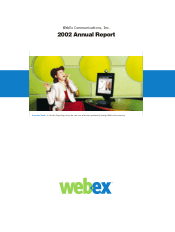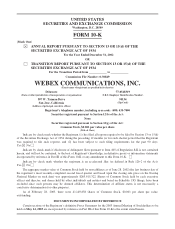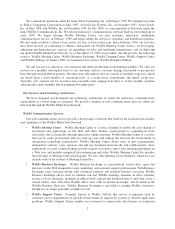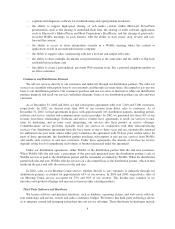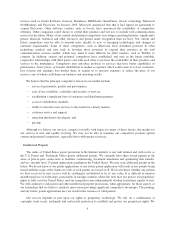WebEx 2002 Annual Report Download - page 10
Download and view the complete annual report
Please find page 10 of the 2002 WebEx annual report below. You can navigate through the pages in the report by either clicking on the pages listed below, or by using the keyword search tool below to find specific information within the annual report.services such as Centra Software, Genesys, Raindance, IBM/Lotus (SameTime), Oracle (i-meeting), Microsoft
(NetMeeting) and Placeware. In January 2003, Microsoft announced that that it had signed an agreement to
acquire Placeware. Other software vendors, such as Oracle, have announced the availability of competitive
offerings. Other companies could choose to extend their products and services to include web communications
services in the future. Many of our current and potential competitors have longer operating histories, significantly
greater financial, technical and other resources and greater name recognition than we have. Our current and
future competitors may be able to respond more quickly to new or emerging technologies and changes in
customer requirements. Some of these competitors, such as Microsoft, have dominant positions in other
technology markets and may seek to leverage those positions to expand their presence in the web
communications services market, which may make it more difficult for other vendors, such as WebEx, to
compete. In addition, current and potential competitors have established, and may in the future establish,
cooperative relationships with third parties and with each other to increase the availability of their products and
services to the marketplace. Competitors may introduce products or services that have better capabilities or
performance, lower prices, or broader distribution or market acceptance which could cause us to lose customers,
lose revenue and earnings, lose market share or require us to increase expenses or reduce the price of our
services, any of which could harm our business and operating results.
We believe that the principal competitive factors in our market include:
ⳮservice functionality, quality and performance;
ⳮease of use, reliability, scalability and security of services;
ⳮestablishing a significant base of customers and distribution partners;
ⳮaccess to distribution channels;
ⳮability to introduce new services to the market in a timely manner;
ⳮcustomer service and support;
ⳮattracting third-party developers; and
ⳮpricing.
Although we believe our services compete favorably with respect to many of these factors, the market for
our services is new and rapidly evolving. We may not be able to maintain our competitive position against
current and potential competitors, especially those with greater resources.
Intellectual Property
The status of United States patent protection in the Internet industry is not well defined and will evolve as
the U.S. Patent and Trademark Office grants additional patents. We currently have three issued patents in the
areas of peer-to-peer connections to facilitate conferencing, document annotation and optimizing data transfer,
and we currently have 25 patent applications pending in the United States. We may seek additional patents in the
future. We do not know if our patent applications or any future patent application will result in any patents being
issued with the scope of the claims we seek, if such patents are issued at all. We do not know whether any patents
we have received or may receive will be challenged, invalidated or be of any value. It is difficult to monitor
unauthorized use of technology, particularly in foreign countries where the laws may not protect our proprietary
rights as fully as in the United States, and our competitors may independently develop technology similar to ours.
We will continue to seek patent and other intellectual property protections, when appropriate, for those aspects of
our technology that we believe constitute innovations providing significant competitive advantages. The pending,
and any future, patent applications may not result in the issuance of valid patents.
Our success depends in part upon our rights to proprietary technology. We rely on a combination of
copyright, trade secret, trademark and contractual protection to establish and protect our proprietary rights. We
6

